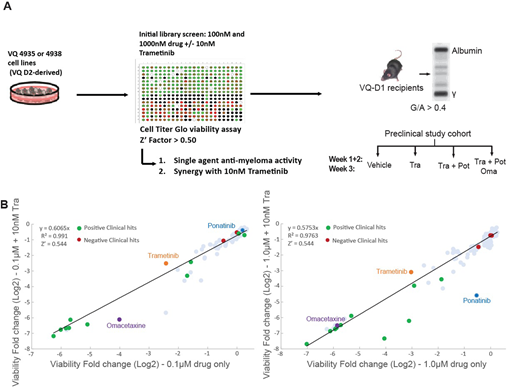Multiple myeloma (MM) is characterized by clonal expansion of malignant plasma cells (PCs) and aberrant production of monoclonal immunoglobulin detected as an M spike using serum protein electrophoresis. In the United States, MM represents ~15% of hematologic malignancies and is one of the few cancers increasing in incidence (e.g., 14,400 in 1996 to 32,270 in 2020, from SEER). Despite recent treatment advances, patients diagnosed with high risk/refractory MM (hrrMM) have an overall survival of only three years. Recently, our lab developed the first genetically engineered NrasQ61R; Myc-driven myeloma model (VQ mice). The VQ model recapitulates most biological and clinical features of hrrMM. VQ cells are serially transplantable into syngeneic recipients and can be propagated in vitro. As such, the VQ model could serve as a robust pre-clinical platform for drug screening and in vivo testing of new therapies to treat hrrMM.
Whole exome sequencing (WES) of CD138+ cells from five primary VQ mice identified eight recurrently mutated genes. Of these eight genes, two have been previously identified as recurrently mutated in MM patients while the remainder appear to be unique to VQ myeloma. Meanwhile, RNA sequencing of CD138+ cells taken from both primary VQ mice and secondary VQ recipients show differential gene expression for five of these eight genes. Gene ontology analysis of recurrently mutated genes indicates that these genes play a role in interferon signaling, as well as receptor tyrosine kinase signaling.
Here, we report the results of a high-throughput repurposing screen using the NCI's AOD IX library, which consists of 147 FDA-approved anti-cancer drugs. VQ cells were treated with 0.1 and 1µM of each compound in the presence or absence of 10nM of Trametinib (Tra), a potent MEK inhibitor. Screening results returned expected positive hits that were previously FDA approved for MM treatment (green dots, Panel 1B), such as proteasome inhibitors, histone deacetylase inhibitors, and chemotherapy drugs. Importantly, VQ cells were resistant to some compounds currently used to treat MM, including the BCL-2 inhibitor Venetoclax, the alkylating agent Melphalan, and the topoisomerase II inhibitor Etoposide (red dots, Panel 1B). De novo resistance to these therapies further indicates that the VQ cells model a multi-drug resistant MM. Two compounds were chosen for further testing: the protein translation inhibitor Omacetaxine (Oma) based on its single agent efficacy, and the multi-receptor tyrosine kinase inhibitor Ponatinib (Pot) based on its high synergy with Tra. Combination Index testing confirmed initial drug screening results but showed some antagonism between combination Oma and Pot treatment.
We proceeded with in vivo testing of two novel combination therapies, in which 3-week treatment cycles were followed by a 1-week rest period between cycles: Three weeks of daily Tra and Pot treatment (TP), or two weeks of Tra and Pot treatment followed by one week of Oma (TPO) treatment. Vehicle (Veh) treated and Tra only treated mice were used as controls. Treatment efficacy was assessed against VQ-D1 MM, which grows primarily in the bone marrow (BM) and metastasizes to the spleen and liver of recipient mice. Four weeks post-treatment, myeloma growth in the BM was significantly reduced in both combo treatment groups, while MM burden in the spleen was also reduced. Overall, both TP and TPO treatment significantly extended survival compared to Veh or Tra treated mice, and significantly reduced liver extramedullary disease. To further test the range of Tra/Pot synergy in vivo, Tra dosage was reduced and treatment was administered daily. Interestingly, both low dose Tra monotherapy and TP combo therapy significantly extended survival compared to Veh control or Pot alone, and TP treated mice had increased survival compared to the Tra only treated mice.
Taken together, our results show that low dose daily Trametinib treatment is superior to cycling dosage, and that Ponatinib treatment synergizes with both dosing schedules to extend survival in vivo. Our study demonstrates the utility of the VQ model for identifying new treatments for hrrMM and testing their efficacy in vivo. As part of our ongoing drug repurposing experiments, we have expanded our screening to a panel of 2,580 FDA-approved drugs, including but not limited to anti-cancer and anti-inflammatory drugs.
Callander:Cellectar: Research Funding; University of Wisconsin: Current Employment.
Author notes
Asterisk with author names denotes non-ASH members.


This feature is available to Subscribers Only
Sign In or Create an Account Close Modal